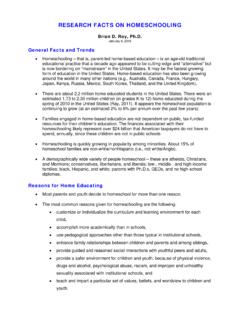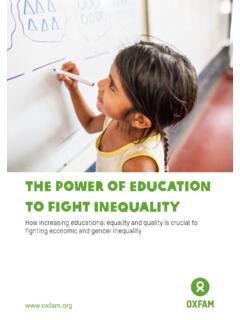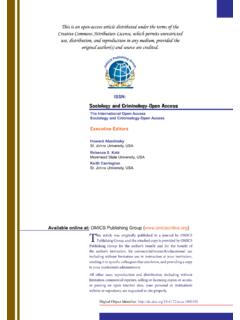Transcription of Growth and its Impact on Economic Trends in Income Inequality
1 Please cite this paper as:Cingano, F. (2014), Trends in Income Inequality and itsImpact on Economic Growth , OECD Social, Employment andMigration Working Papers, No. 163, OECD Social, Employment and MigrationWorking Papers No. 163 Trends in Income Inequalityand its Impact on EconomicGrowthFederico CinganoJEL Classification: H23, J62, O15, O47 Unclassified DELSA/ELSA/WD/SEM(2014)9 Organisation de Coop ration et de D veloppement conomiques Organisation for Economic Co-operation and Development _____ English - Or. English DIRECTORATE FOR EMPLOYMENT, LABOUR AND SOCIAL AFFAIRS EMPLOYMENT, LABOUR AND SOCIAL AFFAIRS COMMITTEE OECD SOCIAL, EMPLOYMENT AND MIGRATION WORKING PAPERS No. 163 Trends IN Income Inequality AND ITS Impact ON Economic Growth Federico Cingano JEL codes: O15, O47, J62, H23 Authorised for publication by Stefano Scarpetta, Director, Directorate for Employment, Labour and Social Affairs.
2 All Social, Employment and Migration Working Papers are available on Complete document available on OLIS in its original format This document and any map included herein are without prejudice to the status of or sovereignty over any territory, to the delimitation of international frontiers and boundaries and to the name of any territory, city or area. DELSA/ELSA/WD/SEM(2014)9 Unclassified English - Or. English DELSA/ELSA/WD/SEM(2014)9 2 DIRECTORATE FOR EMPLOYMENT, LABOUR AND SOCIAL AFFAIRS OECD SOCIAL, EMPLOYMENT AND MIGRATION WORKING PAPERS OECD Working Papers should not be reported as representing the official views of the OECD or of its member countries. The opinions expressed and arguments employed are those of the author(s). Working Papers describe preliminary results or research in progress by the author(s) and are published to stimulate discussion on a broad range of issues on which the OECD works. Comments on Working Papers are welcomed, and may be sent to the Directorate for Employment, Labour and Social Affairs OECD, 2 rue Andr -Pascal, 75775 Paris Cedex 16, France.
3 This series is designed to make available to a wider readership selected labour market, social policy and migration studies prepared for use within the OECD. Authorship is usually collective, but principal writers are named. The papers are generally available only in their original language English or French with a summary in the other. The statistical data for Israel are supplied by and under the responsibility of the relevant Israeli authorities. The use of such data by the OECD is without prejudice to the status of the Golan Heights, East Jerusalem and Israeli settlements in the West Bank under the terms of international law. Applications for permission to reproduce or translate all or part of this material should be made to: Head of Publications Service OECD 2, rue Andr -Pascal 75775 Paris, CEDEX 16 France Copyright OECD 2014 DELSA/ELSA/WD/SEM(2014)9 3 TABLE OF CONTENTS ABSTRACT .. 6 R SUM .. 7 Trends IN Income Inequality AND ITS Impact ON Economic Growth .
4 8 1. The long-term rise in Income Inequality in the OECD area .. 8 A trend toward growing disparities before and since the Great Recession .. 8 2. How Inequality may affect Economic Growth .. 10 Theoretical 10 Empirical evidence .. 12 3. The Impact of Inequality on Growth .. 14 A summary of the approach and the new evidence .. 14 Baseline results .. 16 Redistribution .. 19 Top and bottom Inequality .. 20 4. Inequality , social mobility and human capital accumulation .. 22 5. Concluding remarks .. 28 REFERENCES .. 30 ANNEX 1. ADDITIONAL TABLES AND FIGURES .. 35 ANNEX 2. SYNTHESIS OF LITERATURE REVIEW .. 37 ANNEX 3. ESTIMATING THE Inequality , SOCIAL MOBILITY AND Growth NEXUS: TECHNICAL ANNEX .. 42 Introduction .. 42 The Impact of Inequality on Growth .. 42 The Growth equation .. 42 The empirical model and data .. 45 Inequality , social mobility and human capital investment .. 46 Evidence from PIAAC: Data and empirical specification.
5 46 Inequality , background and educational attainments .. 47 Inequality , background and skills .. 50 Inequality , family background and employment probability .. 53 REFERENCES FOR ANNEX 3 .. 55 Tables Table 1: The Inequality - Growth nexus in OECD countries: baseline results .. 17 Table 2: Inequality at the bottom and at the top of the distribution .. 21 Table : Trends in real disposable household Income by Income group, pre-crisis and post-crisis period .. 35 Table : Recent Trends in different Income Inequality measures .. 36 Table : Summary of main cross-country reduced-form studies on Inequality and Growth .. 37 Table Summary of main studies on intermediate theoretical mechanism .. 40 Table Years of schooling, Family background and Inequality .. 57 Table Numeracy scores, Family background and Inequality .. 58 Table Literacy scores, Family background and Inequality .. 59 DELSA/ELSA/WD/SEM(2014)9 4 Figures Figure 1: Income Inequality increased in most, but not all OECD 9 Figure 2: Inequality increased over the long run but temporarily stalled during the first crisis years.
6 10 Figure 3: Estimated consequences of changes in Inequality on cumulative per capita GDP Growth (1990-2010) .. 18 Figure 4: Inequality and enrolment rates across OECD countries, 2010 .. 23 Figure 5: Average probability of tertiary education by parental educational background and Inequality . 25 Figure 6: Average numeracy score by parent educational background and Inequality .. 27 Figure : Probability of lower sec. education (or less) by Parent Educational Background and Inequality .. 48 Figure : Years of schooling by Parent Educational Background and Inequality level .. 49 Figure : Numeracy scores, Family background and Inequality .. 51 Figure : Literacy scores, Family background and Inequality .. 52 Figure : Probability of not being employed over working life .. 54 Boxes Box 1. GMM estimators in Growth regressions .. 15 Box 2. The long-run aggregate implied effects .. 28 DELSA/ELSA/WD/SEM(2014)9 5 AKNOWLEDGMENT This paper was prepared within the OECD initiative on New Approaches to Economic Challenges (NAEC), as part of Project B6: Closing the Loop: How Inequality Affects Economic Growth and Social Cohesion.
7 The author is grateful to Andrea Bassanini, Paolo Falco, Michael F rster, Christian Kastrop, Mark Pearson, Monika Queisser, Stefano Scarpetta and Tim Smeeding for helpful discussions and valuable comments on an earlier draft of the paper, and to Anna D Addio, Angelica Salvi Del Pero, Maxime Ladaique and Horacio Levy for help with the data. This work also benefited from the comments received by delegates and participants to the meetings of the ELSA Committee, the OECD Economic Policy Committee, the Working Party on Social Policy and to the NAEC seminar series. DELSA/ELSA/WD/SEM(2014)9 6 ABSTRACT 1. In most OECD countries, the gap between rich and poor is at its highest level since 30 years. Today, the richest 10 per cent of the population in the OECD area earn times the Income of the poorest 10 per cent; in the 1980s this ratio stood at 7:1 and has been rising continuously ever since. However, the rise in overall Income Inequality is not (only) about surging top Income shares: often, incomes at the bottom grew much slower during the prosperous years and fell during downturns, putting relative (and in some countries, absolute) Income poverty on the radar of policy concerns.
8 This paper explores whether such developments may have an Impact on Economic performance. 2. Drawing on harmonised data covering the OECD countries over the past 30 years, the econometric analysis suggests that Income Inequality has a negative and statistically significant Impact on subsequent Growth . In particular, what matters most is the gap between low Income households and the rest of the population. In contrast, no evidence is found that those with high incomes pulling away from the rest of the population harms Growth . The paper also evaluates the human capital accumulation theory finding evidence for human capital as a channel through which Inequality may affect Growth . Analysis based on micro data from the Adult Skills Survey (PIAAC) shows that increased Income disparities depress skills development among individuals with poorer parental education background, both in terms of the quantity of education attained ( years of schooling), and in terms of its quality ( skill proficiency).
9 Educational outcomes of individuals from richer backgrounds, however, are not affected by Inequality . 3. It follows that policies to reduce Income inequalities should not only be pursued to improve social outcomes but also to sustain long-term Growth . Redistribution policies via taxes and transfers are a key tool to ensure the benefits of Growth are more broadly distributed and the results suggest they need not be expected to undermine Growth . But it is also important to promote equality of opportunity in access to and quality of education. This implies a focus on families with children and youths as this is when decisions about human capital accumulation are made -- promoting employment for disadvantaged groups through active labour market policies, childcare supports and in-work benefits. DELSA/ELSA/WD/SEM(2014)9 7 R SUM 1. Dans la plupart des pays de l'OCDE, le foss entre riches et pauvres est son plus haut niveau depuis 30 ans.
10 Aujourd'hui, dans la zone de l'OCDE, les 10% de la population les plus riches gagnent 9,5 fois le revenu des 10 % les plus pauvres; dans les ann es 1980, ce ratio s' levait 7: 1 et il a augment de fa on continue depuis. Toutefois, la hausse de l'in galit de revenu n'est pas (seulement) relative la flamb e de la part des plus hauts revenus : souvent, les revenus les plus bas ont augment beaucoup plus lentement pendant les ann es prosp res, et sont tomb s en p riode de ralentissement conomique, mettant la pauvret mon taire relative (et, dans certains pays, absolue) sur le radar des pr occupations politiques. Ce document cherche savoir si ces volutions peuvent avoir un Impact sur la performance conomique. 2. S'appuyant sur des donn es harmonis es couvrant les pays de l'OCDE au cours des 30 derni res ann es, l'analyse conom trique sugg re que les in galit s de revenus ont un Impact n gatif et statistiquement significatif sur la croissance ult rieure.














